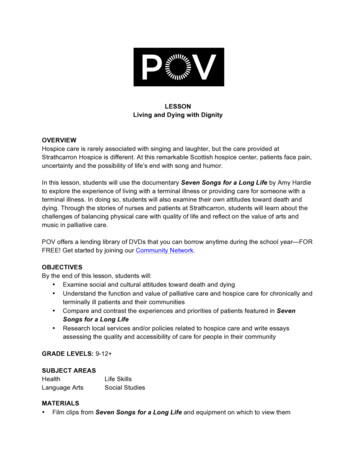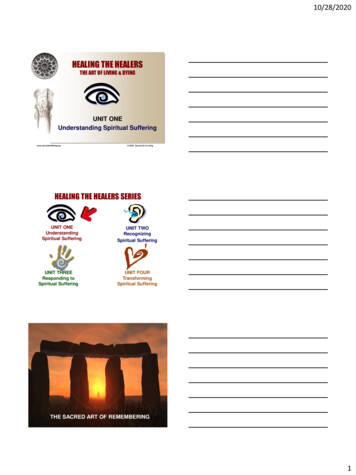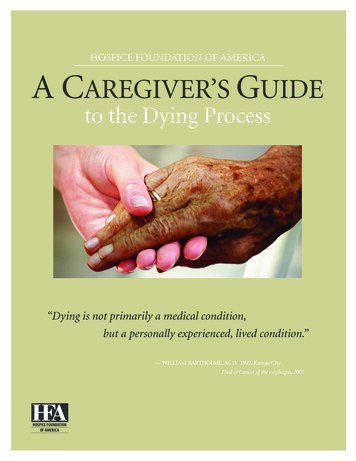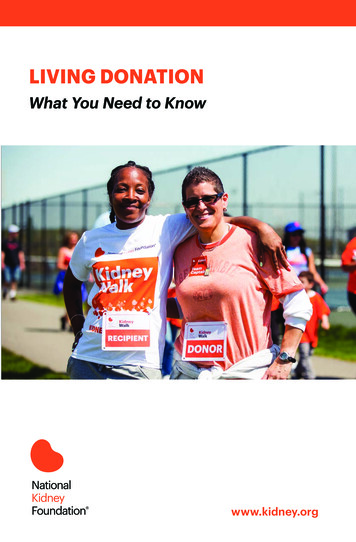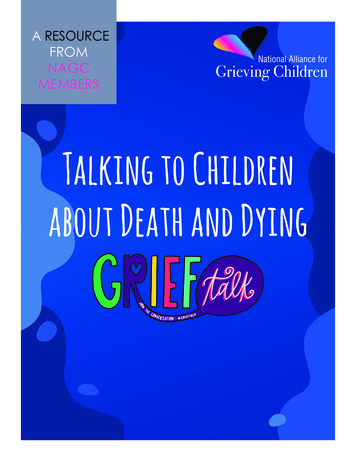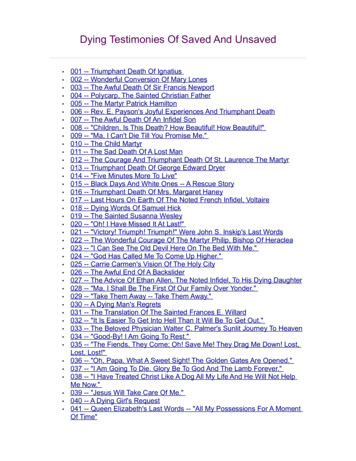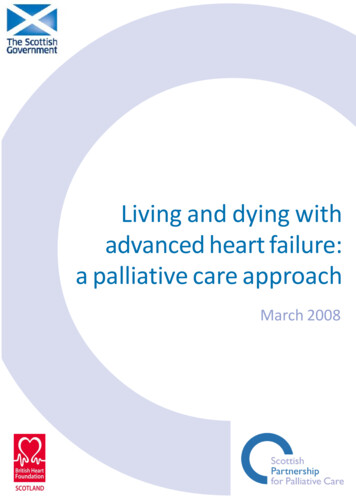
Transcription
Living and dying withadvanced heart failure:a palliative care approachMarch 2008a palliative care approach1
Additional copies of this report are available from the office of the Scottish Partnership for PalliativeCare or by downloading from www.palliativecarescotland.org.uk2Living and dying with advanced heart failure:
Living and dying withadvanced heart failure:a palliative care approachMarch 2008a palliative care approach3
ForewordAs this highly significant report acknowledges, the Coronary Heart Disease(CHD) and Stroke Task Force recommended back in 2001 that provisionshould be made to meet the palliative care needs of people with end-stageheart failure. A succession of reports from the Scottish Audit of SurgicalMortality has highlighted the plight of those with conditions such as end-stageheart failure dying in acute hospitals, with a worse prognosis and poorerquality of life than many cancer patients, but with no access to the benefitsthat palliative care could bring. We now have SIGN Guideline 95 on themanagement of chronic heart failure, with a section on palliative care thatincludes a clear recommendation that a palliative care approach should beadopted by all clinicians managing patients with chronic heart failure in the earlystages of the disease (my emphasis).People with heart failure and their carers, this report tells us, may complain that they are uninformedabout their condition, are excluded from decision-making and feel that control of their lives is taken awayfrom them. This is the polar opposite of the approach we are encouraging to the management of long termconditions. The aim should be to regard people and their carers as equal partners in their care, to recognisethe expertise which they inevitably develop in living with these conditions and to help them achieve thebest quality of life possible.The key to this, as to so much in good medicine, lies in communication, whether with people with heartfailure and their carers, or among the wide range of agencies involved in the provision of care. Adoption ofa palliative care approach is central to the promotion of good communication.There are a number of ways we can take forward implementation of the recommendations in the report.We will incorporate the essence of them in the refreshed version of our CHD & Stroke Strategy, aconsultation version of which we will be issuing shortly. The heart failure report highlights the role of boththe cardiac Managed Clinical Networks and the palliative care MCNs in taking forward implementationlocally, and I know they will be able to look for support, as needed, from the National Centre for theTreatment of Advanced Heart Failure. The recommendations will also contribute to the work which NHSQuality Improvement Scotland is beginning to undertake on translating the various SIGN Guidelines onheart disease, including SIGN 95, into clinical standards and other mechanisms, such as the heart failureaudit.I fully endorse what I think is one of the most important statements in the report: that the inherentunpredictability of the disease is not sufficient justification for a failure to introduce appropriate palliativecare to the ongoing management and support of those with heart failure.DR HARRY BURNSChief Medical Officer for Scotland4Living and dying with advanced heart failure:
PrefaceThis document is timely because palliative care has been on the periphery of themanagement of heart failure for far too long. Medical research has yielded a richharvest of new technologies, both pharmacological and interventional, which havethe potential substantially to improve survival. But patients admitted to ourhospitals with worsening heart failure still stand only a 60% chance of being alivejust one year later. This is because, in ‘real life’ clinical practice, patients are older,often have multiple co-morbidities and rarely achieve the high level ofconcordance with their care plans reported in clinical trials. There is animportant message here because recent audit data suggests that outcomes inheart failure are generally poorer in the UK countries as compared to otherdeveloped nations. And audit data from England and Wales show that theimplementation of evidence based management of heart failure is variable andgenerally suboptimal, suggesting that the continuing high mortality and morbidityfrom and re-hospitalisation for worsening heart failure could, in part, be related to poor quality of care.While the recently funded QIS audit of heart failure care will soon provide data specifically from Scotland itwould be foolish to assume that our patients fare any better.Of course what all patients with heart failure deserve is a coherent care plan based on an accurate diagnosisand assessment of the severity of their heart failure within a robust and integrated programme for heartfailure implemented across all sectors of the healthcare system. Central to such a programme should beimproving not only the prognosis for our patients but also the quality of their lives. Palliative care, therefore,should be a core component of this process since helping people to feel better, eventually, will be moreimportant than extending life.An important recommendation of this report is that the implementation of the palliative approach shouldbe through the present heart failure multidisciplinary team in association with the specialist palliative caresystem. This will help ensure that patients with advanced heart failure will be properly reassessed toconfirm that palliation is the appropriate choice among an increasing number of strategies including thebetter application of best medical treatment, devices, other interventions and conventional and transplantsurgery. Acquisition of basic palliative medicine skills by a wider group of healthcare professionals also willprotect the specialist palliative care services from being overstretched by this new constituency of patients.Living and dying with advanced heart failure: a palliative care approach clearly describes the potentially extensivescope of palliative care in heart failure and makes many sensible and practical recommendations. But thescale of their implementation will be determined by fundholders. Inevitably, translating theserecommendations into practice will mean making choices about where gains can be made most effectivelyand rewardingly for patients. For those patients who, despite our best efforts, are close to the end of theirlives, many will agree that making the quality of their life our primary aim would be an excellent start.HENRY J DARGIEDirectorScottish Advanced Heart Failure ServiceGolden Jubilee National Hospital, Glasgowa palliative care approach5
6Living and dying with advanced heart failure:
Contents1.Executive Summary2.Background3.4.5.6.092.1Policy framework102.2Purpose of this report10What is heart failure and how is it treated? – the clinical perspective3.1What is heart failure?113.2Facts and figures113.3Disease trajectory113.4Prognostic uncertainty123.5Conventional treatment strategies123.5.1 Drug treatments123.5.2 Additional treatments133.5.3 Treatment of co-morbidities133.6Advanced heart failure133.7The terminal stage of heart failure and diagnosing dying13Living and dying with heart failure - the patient and carer experience4.1What is the impact of advanced heart failure on patients and carers?154.2Continuity and co-ordination of care154.3Quality of life issues15Introducing palliative care5.1What is palliative care?165.2Why do patients with advanced heart failure need palliative care?165.3When should palliative care be introduced?165.4Providing palliative care for patients with advanced heart failure175.4.1 Referral for specialist palliative care18The palliative care approach in advanced heart failure6.1Communication196.1.1 Breaking bad news196.1.2 Advance care planning196.1.3 Advance decisions (living wills)206.1.4 Sudden cardiac death206.1.5 Cardiopulmonary resuscitation (CPR) and Do Not AttemptResuscitation (DNAR) orders206.1.6 Deactivation of implantable cardioverter defibrillators (ICDs)21a palliative care approach7
Contents6.The palliative care approach in advanced heart failure (continued)6.26.36.47.9.Symptom management216.2.1 A palliative care approach to symptom management216.2.2 Symptom control when patients can no longer tolerate oralmedication22Psychosocial and spiritual care226.3.1 Psychological issues226.3.2 Information needs226.3.3 Social needs236.3.4 Financial issues236.3.5 Spiritual needs23Terminal care246.4.1 Discontinuation of active treatment246.4.2 Implementation of an integrated care pathway246.4.3 Preferred place of care25Delivering more effective services for people with advancedheart failure7.1Continuity and co-ordination of care267.2Supporting patients in the community267.2.1 The role of the heart failure specialist nurse267.2.2 Gold Standards Framework277.3Decisions regarding hospitalisation277.4Overcoming barriers to delivering more effective services287.5Education, training and sharing expertise287.5.1 General palliative care skills287.5.2 Enhanced communication skills28Future research needs297.68.Conclusions and recommendations30AppendicesAppendix 1Symptom management and palliative care33Appendix 2Examples of approach to reassessment of medicationin advanced heart failure36Suggested approaches to some difficult end of lifequestions38Appendix 4Additional reading and resources41Appendix 5References44Appendix 6Acknowledgements49Appendix 38(continued)Living and dying with advanced heart failure:
1. Executive summaryThis report highlights some of the significant challenges in the journey faced by patients and carers living anddying with advanced heart failure, and makes recommendations regarding key elements of good practice andthe delivery of more effective services which might help to address their palliative care needs.Compared to many cancer patients, those with heart failure have a worse prognosis, poorer quality of life,and more limited access to social services and to palliative care support. 50% of patients with advancedheart failure die within a year of diagnosis and 50% of the remainder within five years. It is difficult topredict individual prognosis, largely because as many as 50% of heart failure patients die suddenly andunexpectedly.Most patients with advanced heart failure have a combination of medical, social, psychological, spiritual andemotional needs which are best addressed by a combination of ongoing optimum active cardiologicaltreatment and the early and phased implementation of a palliative care approach by all professionalsroutinely involved in their care. Specialist palliative care services should be accessed when required for theminority who have complex needs.All patients with advanced heart failure and their carers should have the opportunity to discuss andunderstand the diagnosis and its implications, as well as to be involved in treatment plans and to exerciseinformed choice where appropriate. Wider recognition of heart failure as a terminal condition whichadversely affects the quality of life of patients and carers would facilitate better service provision. Improvedcommunication skills and greater openness on the part of clinicians in discussing sensitive issues aroundprognosis and end of life issues would enhance the quality of life of patients and families and later contributeto the well-being of the bereaved.A shared care approach is needed, with the key roles undertaken by primary care and cardiology servicesand additional services such as specialist palliative care accessed as required. Effective communication andcollaboration across all sectors and disciplines, including out of hours care, and effective co-ordination ofcare by a named individual such as a heart failure specialist nurse or other suitably trained healthprofessional, are crucial in addressing the inherent difficulties and uncertainties of the patient journey.Reciprocal opportunities to share knowledge, experience and educational opportunities and to gain greaterunderstanding of the management of patients with advanced heart failure and of relevant palliative carestrategies should be available to all health and social care teams involved. Consideration should be given toissues such as workforce planning, reorganisation of existing services and the provision of additionalresources in order to implement the recommendations contained within this report.a palliative care approach9
2. Background2.1 Policy frameworkIt is the policy of the Scottish Government that good palliative care should be available to anyone sufferingfrom a progressive, incurable condition, and previous Scottish Executive publications refer specifically to theneeds of people with heart failure in this context1. The report by Professor David Kerr2 and the ScottishExecutive response, Delivering for Health3, highlighted the implications for Scotland’s healthcare of an ageingpopulation and the challenges arising particularly from the management of multiple long-term conditions inthe community. The Scottish Government Better Health, Better Care: Action Plan4 further develops thisagenda with a commitment to developing a national palliative care Action Plan in 2008.The palliative care needs of people with heart failure have been acknowledged in policy developmentsthroughout the UK5,6,7. In Scotland, a key development has been the publication of the ScottishIntercollegiate Guidelines Network (SIGN) and NHS Quality Improvement Scotland National ClinicalGuideline: 95 Management of chronic heart failure8.2.2 Purpose of this reportThis report is a policy document outlining key issues and themes which should be considered in theongoing development of local strategies for the palliative care of patients with advanced heart failure. Alimited amount of detail is included, and the report functions mainly as a signpost to key issues and tofurther sources of information. Although the document and its recommendations focus on patients withadvanced heart failure, many of the principles outlined may apply equally to those at earlier stages of thedisease.The report is based on existing evidence and on evidence informed good practice: the report’s content is referenced wherever possible to published opinion and peer-reviewed research where no such evidence is available, the statements and recommendations in the report are also based on the experience and opinion of members of the working group, who are all experts in their fields, andof additional experts who contributed through the consultation processthe report is underpinned by awareness on the part of the working group and those who contributedthrough the consultation process of relevant local and regional guidelinesthe report contains an Appendix with general information on symptom management, but does notpurport to be a comprehensive symptom control guide.The report aims to provide clarification for clinicians and strategists regarding the principles of palliative careand why it is important in the management of advanced heart failure. It is relevant to policy makers andplanners as well as to clinicians, and is intended to be of use to professionals across all sectors, specialtiesand disciplines who are involved in the care of people with advanced heart failure and their families, as wellas to Managed Clinical and Managed Care Networks, Community Health Partnerships, NHS Boards, localauthorities and other relevant bodies.10Living and dying with advanced heart failure:
3. What is heart failure and how is it treated?- the clinical perspective3.1 What is heart failure?Heart failure is a chronic progressive condition resulting from weakness of the heart muscle. Thecommonest causes of heart failure in the western world are coronary artery disease and hypertension.3.2 Facts and figuresCurrently 3% of the UK population over 45 years old are thought to be affected by heart failure9 withfigures for the over 75s rising to 7%, and to 15% for the over 85s. In 2007 it was estimated that as many as100,000 people in Scotland were living with heart failure10. With an increasingly elderly population, it isthought that the prevalence of heart failure could increase by as much as 70% by 201011.In most cases heart failure is incurable. Death may occur within a few weeks of diagnosis, but some patientssurvive for ten or more years. Commonly quoted mortality data are that 50% of patients in NYHA class IV(symptoms at rest, see table 1) despite optimal medication die within a year and 50% of the remainder diewithin 5 years12. More recent data suggests improved survival, mainly in relatively young patients able totolerate optimum treatment. The mortality rate will decline further in eligible patients as devices such asimplantable cardioverter defibrillators (ICDs) and pacemaker therapies are more widely used13.3.3 Disease trajectoryA particular feature of heart failure is that up to 50% of patients die suddenly and unpredictably at any stageduring the course of the disease14,15, although the increasing use of automated implantable defibrillators willimpact on these figures. For the majority of the remaining patients, disease progression is likely to follow thepattern below: the onset of symptoms (a combination of breathlessness, fatigue and oedema)an improvement in symptoms following the initiation of standard treatmenta period of symptom stability enabling many patients to return to some level of normal activitythe return of symptoms which become increasingly resistant to treatment: this characterises the stageof advanced heart failure (3.6)progressive deterioration marked by episodes (possibly reversible) of decompensationterminal stage: the last few days of life (3.7).Symptomatic improvement in response to treatment and the subsequent deterioration can be usefullyassessed using the New York Heart Association Functional Classification scale (see Table 1).Table 1 : New York Heart Association (NYHA) ClassificationClassSymptomsI:No limitation: ordinary physical exercise does not cause undue fatigue, dyspnoea orpalpitationsSlight limitation of physical activity: comfortable at rest but ordinary activity results infatigue, palpitations or dyspnoeaMarked limitation of physical activity: comfortable at rest but less than ordinary activityresults in symptomsUnable to carry out any physical activity without discomfort: symptoms of heartfailure are present even at rest with increased discomfort with any physical activityII:III:IIII:(The Criteria Committee of the New York Heart Association16)a palliative care approach11
The overall progression of heart failure, compared to the trajectories of cancer and dementia/frailty, is shown in Figure 1.Figure 1: Typical illness trajectories for people with progressivechronic illness.Murray et al 200517. Adapted from Lynn & Adamson200318.Reproduced with permission from BMJ Publishing GroupLtd and RAND Corporation, Santa Monica, California,USA.3.4 Prognostic uncertaintyThe rate of progression of heart failure in individual patients is unpredictable. Three key factors contributeto the uncertainties experienced: cardiac events which commonly precipitate hospitalisation, such as myocardial infarction, unstable anginaand atrial fibrillation, can occur at any timesudden death may occur at any point in the disease trajectoryit can be difficult to identify when a patient is terminally ill.3.5 Conventional treatment strategiesOptimal treatment relieves symptoms, improves prognosis and can temporarily reverse the effects ofmyocardial damage. Disease progression is slowed, not halted.3.5.1 Drug treatmentsDrug treatment is based on a combination of medications which are incrementally titrated up towards the12Living and dying with advanced heart failure:
optimum dosage. This process may take several months. It involves finding a balance between achieving thedesired dosage of each drug and avoiding or minimising side effects, including unacceptable deterioration inrenal function (see Appendix 2 ‘Examples of approach to reassessment of medication in advanced heartfailure’ and Appendix 1, ‘Renal impairment’). Comprehensive details of treatment and management of heartfailure are provided in local, national and international guidelines.3.5.2 Additional treatmentsAdditional forms of treatment are appropriate for some patients: surgery for coronary artery or valvular diseasespecific treatment protocols for those hospitalised with episodes of acute decompensated heart failureimplantable cardioverter defibrillators (ICDs)cardiac resynchronisation therapyarrhythmia management.Lifestyle changes including dietary measures, fluid adjustment, and exercise programmes may berecommended.3.5.3 Treatment of co-morbiditiesHeart failure, especially in the elderly, is characterised by a high prevalence of co-morbidities (see Table 2).Most patients have three or more additional conditions. These may be more distressing than the heartfailure itself, and often adversely affect quality of life and prognosis19. Treatment of co-morbidities may beneglected when treatment of heart failure is prioritised20,21.Table 2: Common co-morbidities in heart failureAnaemiaChronic renal diseaseChronic obstructive pulmonary diseaseCognitive dysfunctionDepressionDiabetesPeripheral vascular diseaseStroke disease3.6 Advanced heart failureAdvanced heart failure is defined as the presence of severe symptoms and poor exercise tolerance (NYHAFunctional Class III or IV) which have persisted for at least three months despite attempts to optimisestandard therapy22. In practice, the onset of this stage is identified with hindsight but it neverthelessrepresents a watershed in the patient’s management. Many patients face recurrent episodes ofhospitalisation, usually caused by worsening heart failure and its complications, or by problems relating tomedication or to a co-morbidity23. Treatments outlined above (3.5.2) may be appropriate for some of thesepatients. Implementation of a palliative care approach will complement conventional treatment (see 5.3).3.7 The terminal stage of heart failure and diagnosing dyingFollowing an indeterminate period of symptomatic deterioration, usually lasting from a few months to a yearor two, the patient enters the terminal stage of their illness. This may last several days or more and may bethe continuation of a gradual process of deterioration or be triggered by a specific event such as an acutecoronary syndrome or a chest infection.As with other progressive diseases there are no specific indicators that a patient with heart failure is closeto death. Table 3 lists common findings in patients who are terminally ill. These are not diagnostic criteria,a palliative care approach13
and not all will occur in any given case. Where an increasing number are found to be present, this is likelyto herald the onset of the terminal stage.Table 3Common findings in heart failure patients entering the terminal stageGeneric indicators: unable to take oral fluids/medicationincreasingly withdrawn or unresponsiveincreasingly weak/exhaustedbed-bound.Pointers related to advanced heart failure: previous hospitalisation within the past few months or frequent out-patient visits withoutsignificant improvementno further interventions likely to improve the patient’s conditionno reversible cause of current deteriorationunresponsive to maximum tolerated medicationdeteriorating renal functionanaemiahyponatraemiabreathless at rest or on minimal exertion (NYHA class IV)hypotension and persistent tachycardia at restskin breakdown with exudation from oedematous lower limbsdeliriumlife threatening co-morbidity (eg COPD, critical limb ischaemia).There may be failure to recognise or reluctance to accept that this point has been reached for severalreasons: the need to ensure that the current situation is irreversible (the final stage of heart failure can present indifferent ways, and the patient may sometimes respond to treatment)varying the combination and dosages of conventional heart failure medications may result in temporaryimprovement for some patientsthe usual curative focus of medical care, particularly in the acute sector, means that some professionalsmay be reluctant to accept that no further benefit will accrue from any further medical interventions.Careful assessment by the multi-disciplinary team is therefore essential. Recognition and agreement bymembers of the healthcare team that a patient is terminally ill allows the timely planning and implementationof appropriate care (see 6.4).14Living and dying with advanced heart failure:
4. Living and dying with heart failure- the patient and carer experience4.1 What is the impact of advanced heart failure on patients and carers?The effects of advanced heart failure are severe and disabling. Patients have a poorer quality of life thanthose with most other chronic progressive diseases24. There is progressive physical limitation from anearly stage of the disease. Even simple daily tasks become difficult, time consuming or impossible. Theresult is social isolation, with major implications for family relationships and the role of carers. In addition,co-morbidities complicate care management and add to the symptom burden. Patients and carers oftenhave to manage a complex and ever-changing regimen of drugs and side effects are common.4.2 Continuity and co-ordination of carePatients usually present initially to their general practitioner with breathlessness or ankle swelling and maythen be referred to hospital for investigation or specialist advice. For most of the time, they are cared for inthe community by their primary care team, supported if appropriate and where available by a heart failurespecialist nurse. Recurring episodes of hospitalisation are common, however, and some patients arediagnosed only as a result of an emergency hospital admission. Hospital care is more likely to be providedby a general physician or geriatrician rather than by a cardiologist, and patients will not necessarily be caredfor by the same hospital team on subsequent admissions. The number of different professionals involvedoften results in fragmented and unco-ordinated care.4.3 Quality of life issuesThe combined impact of physical symptoms, co-morbidities, and the psychological and social results ofunco-ordinated care and poor communication all contribute to the poor quality of life of patients with heartfailure25 (see Chapter 6). Patients and families are often poorly informed about heart failure, its treatmentand prognosis. This may result in: insufficient opportunities for patients and carers to discuss and understand the diagnosis and itsimplicationsinsufficient involvement of patients and carers in treatment planninglimited opportunities to make informed decisions and express preferences about goals of care andpreferred place of deathreduced opportunities to address ‘unfinished business’ including practical and legal issues and to receivepsychological and spiritual supportlack of information on eligibility for welfare benefitsless likelihood of receiving appropriate end of life care delivered in a proactive way.a palliative care approach15
5. Introducing palliative care5.1 What is palliative care?Palliative care is a comprehensive and proactive approach to the care of patients whose disease is notresponsive to curative treatment. The World Health Organization describes palliative care as:‘ an approach that improves the quality of life of patients and their families facing the problemsassociated with life-threatening illness, through the prevention and relief of suffering by means of earlyidentification and impeccable assessment and treatment of pain and other problems, physical, psychosocialand spiritual. Palliative care: provides relief from pain and other distressing symptomsaffirms life and regards dying as a normal processintends neither to hasten nor postpone deathintegrates the psychological and spiritual aspects of patient careoffers a support system to help patients live as actively as possible until deathoffers a support system to help the family cope during the patients illness and in their own bereavementuses a team approach to address the needs of patients and their families, including bereavementcounselling, if indicatedwill enhance quality of life, and may also positively influence the course of illnessis applicable early in the course of illness, in conjunction with other therapies that are intended toprolong life and includes those investigations needed to better understand and managedistressing clinical complications.’(World Health Organization26)Effective palliative care consists of a combination of disease management, symptom control and psychosocialcare. It includes, but is not synonymous with, terminal care. Its focus is quality of life, including quality ofdying, and it aims to address the whole person, not just the disease. It relies heavily on a holistic approachand on open and sensitive communication with patients, informal carers and professional colleagues.Although developed for patients with cancer, the principles and practices of palliative care are generic: theyare equally appropriate for patients with other progressive incurable diseases, including advanced heartfailure.5.2 Why do people with advanced heart failure need palliative care?The advanced stages of heart failure can have a devastating effect on the quality of life of patients, which isoften characterised by complex co-morbidities and frequent admissions to hospital14,27,28. Compared topatients with cancer, those with advanced heart failure have a worse prognosis and less access to social andfinancial support. In addition, they are less well informed about their condition and have less opportunity toaddress end of life issues25,29. Symptom relief has been shown to be inadequate in a majori
4 Living and dying with advanced heart failure: Foreword As this highly significant report acknowledges, the Coronary Heart Disease (CHD) and Stroke Task Force recommended back in 2001 that provision should be made to meet the palliative care needs of people with end-stage heart failure. A succession of reports from the Scottish Audit of Surgical




